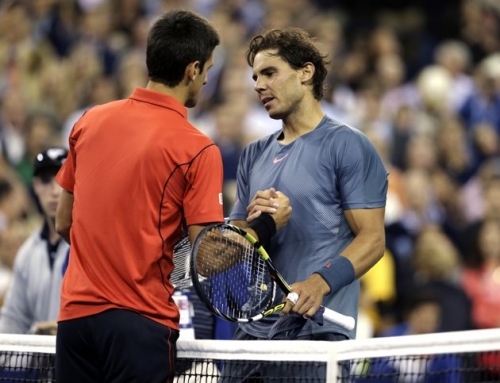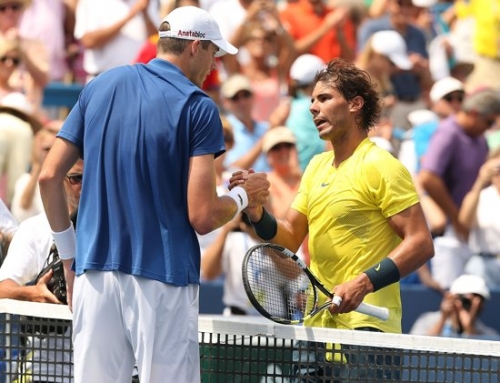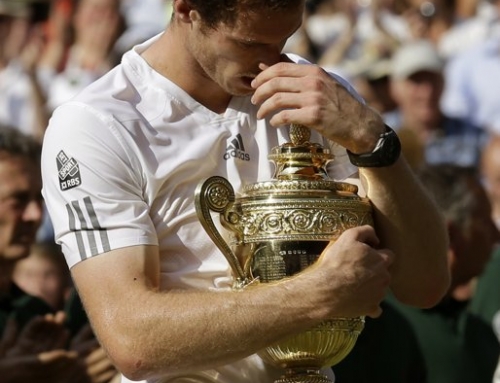 Andy Murray has been called a counterpuncher, but he’s not exactly a counterpuncher in the classic way. Back when Andy Murray was rising in the ranks, he relied more on change of spins and pace and finesse drop shots to win matches. Murray’s big strength then as it is now is his tremendous speed and anticipation as well as his return of serve.
Andy Murray has been called a counterpuncher, but he’s not exactly a counterpuncher in the classic way. Back when Andy Murray was rising in the ranks, he relied more on change of spins and pace and finesse drop shots to win matches. Murray’s big strength then as it is now is his tremendous speed and anticipation as well as his return of serve.
Back in 2008, Murray was unusual. Most male players grow up playing a machismo style. They want to hit as hard as they can. They crave power. They don’t mind that power leads to errors. You can see this style in players like Verdasco or Gonzalez or James Blake. They win because they hit hard. Even standard baseliners of today, Wawrinka, Tipsarevic, Almagro hit the ball pretty hard without necessarily going for winners. David Ferrer hits pretty hard, but doesn’t go for winners partly because he doesn’t seem to generate that kind of power or because he doesn’t want to.
Compared to all these players, Murray used to hit somewhat softer than any of them. This meant Murray’s opponents could tee off on his shots a little more easily. Murray didn’t mind. He was fast. Indeed, it seemed like he wanted his opponents to attack him. Murray, in those days, stood way back, 6-10 feet behind the baseline, and this strategy of not hitting hard and allowing his opponents to strike first was part of the Venus fly trap. Come into my parlor, said the spider to the fly. And if they attacked the net, Murray would rush to the ball, hit a great pass, and he’d win the point.
Sometimes he’d vary up the pace. Slice, slice, topspin, etc. All this change of pace would disrupt the timing of some players, and they would mishit the shot.
However, these tactics never seemed to work against the very best. It’s really, really hard to throw Nadal’s timing off. Nadal can hit balls that barely come off the ground with equal ease as balls bouncing ten feet high with severe topspin. Some of that was Uncle Toni’s desire to get Nadal to win Wimbledon. If low balls were a liability, then he’d be sliced and diced. Indeed, Roger Federer must lament the fact that Nadal can handle such low shots. Early commentators wondered how a clay court player could do so well at Wimbledon, never realizing that he was trained to hit such low shots.
And although Murray is as quick as they come, it’s still hard to run against the hardest hitters in the game. Nadal could take any shot up the middle and hit it hard to one sideline or another creating angles that no one had seen before. And once he pulled you off to that corner, Nadal would pull you off to the other corner. At some point, you’d be barely reaching the ball, still trying to get some pace, land it in the center, and he’d whip a winner.
Today, the successor to Murray is Bernard Tomic who hits even softer and relies on slice on both forehand and backhand. Where Tomic is different is his ability to hit hard flat shots to the corners. Most top pros get a little scared going for the lines. If they aren’t scared, then they are reckless and miss too often. You often see pros hit 5-10 feet from the lines. As a fan, perhaps you yell “hit closer to the lines”. In that case, watch women’s tennis. They aim for the lines a lot. And they miss a lot too, but when they make it, no woman is fast enough to chase it down.
In the calculus of women’s tennis strategy, going for a winner is a viable strategy. Women barely bother to slice. They hit one good shot to the corner and no woman can chase it down. In the men’s game, players like Rafa and Roger and Novak and Andy can chase it down. Rafa won championships because he could take 5 huge shots in a row–and those are being hit by men, not women, get to them, and loop up another shot. Soderling and Berdych only wish their power was so great that Nadal would miss every one of them, but he doesn’t. Perhaps only del Potro hits so hard that Nadal doesn’t get to those shots, but del Potro is smart enough and skillful enough to play steady ball. del Potro is highly underrated for his ability to play lots and lots of balls.
But Tomic has learned to work the corners. Federer has always gone for big shots to the sidelines and Nadal is amazing as well. For as much praise as Tomic gets about his game, he’ll learn, as Andy Murray learn, that it’s not enough. Tomic wants to believe that against him, you’ll make silly mistakes, like Fernando Verdasco made silly mistakes. That you can be lulled by the slice shots and that it will throw off your rhythm. and that you’ll be forced to play Tomic’s game. He’s a pro-level pusher.
Federer, apparently, was lulled into this strategy against Tomic in Davis Cup, and swore that he would not be lulled if they met again. And when they did meet again, Federer went for the lines, forcing Tomic to have to run, his one great weakness. Tomic had to abandon his push, push, push strategy and try to hit with Federer, and that’s where Tomic still needs work. Tomic is a flat hitter (which, by today’s standards, just means a low arcing topspin player) and can be prone to errors for that reason.
Murray learned this lesson years ago. To play someone like Nadal, Murray created a special Nadal strategy. You can’t push, push, push against Nadal because Nadal isn’t bothered by lack of pace, by low shots or hard shots. The only thing that bothers him is pace, and then, only sometimes. His early strategy was to hit a short crosscourt forehand that would land in the service box to Nadal’s backhand. Nadal loves to hit with forehand. He will jump 10 feet wide of the doubles alley to hit a forehand. In his mind, the difference between a backhand and forehand is maybe 10 feet in position. When he has to run 40 feet or more, that extra 10 feet, on slow shots, is no big deal. If he can run around a backhand on a serve, he has time do it off groundstrokes. This short forehand was a way to keep shots to the Nadal backhand.
Nadal’s backhand is, by no means, weak. Nadal can hit amazing passes off that backhand. But in backcourt exchanges, Nadal can’t get the same kind of variety and pop as he does with his forehand. Nadal is almost always hitting a backhand from the backhand corner, so his shots invariably go crosscourt or down the line and occasionally up the middle. He never has to hit that backhand inside-out. The variety and pace are all on his forehand. Opponents therefore try to get to Rafa’s backhand.
Rafa doesn’t make it easy. Because he’s so quick, he camps to his backhand corner to get as many forehands as possible. However, this leaves open his forehand corner. If Rafa leaves a shot up the middle, it can be attacked inside out to his forehand. In the old days, Rafa was particularly vulnerable to this shot. If you hit the shot hard enough, but he could still reach the ball, he would spray that forehand.
Andy Murray used this tactic a lot in the semis against Rafael Nadal and won the match in four sets.
However, despite a strategy that seemed to work against Rafa, Murray never much used this strategy against anyone else. He’d go back to his normal strategy of hitting shots from way behind the baseline, and slicing and dicing. Part of that may be Murray’s mentality. He sees himself as a defensive player. The weird part is that he’s not classic in defense. If you’re going to play defense, you should be a heavy topspin player and you should use that topspin to give yourself more margin. Of the top four, Murray hits the least topspin.
Murray began adding a bit more aggression to his game when he realized that his style of play wasn’t beating Federer at the Slams, and of course, that he couldn’t beat Rafa often enough.
In 2010, Murray played Toronto and, in succession, beat a hot David Nalbandian (the last time Nalbandian was playing really good, and it only lasted maybe 6 weeks), Rafael Nadal, and Roger Federer. He did it by striking the ball pretty hard. Pundits were happy he finally did this, but again, he reverted back to his old style.
Now, Murray has been developing his power shots throughout 2010 and 2011. In particular, Murray altered his forehand motion and was learning to hit a putaway forehand. Against Nadal, Murray really poured on the power on his backhand. Perhaps this was motivated by the fact that Nadal, while being a beast on the baseline, tends to arc his shots when he’s not attacking and that arc leaves the ball high enough that Murray has learned to lean into this shot and basically “hit down”, hard and flat and crosscourt. Most players don’t arc it high enough for Murray to do this.
Djokovic has generally had better luck on tour because Djokovic can play on clay. Why? Djokovic spins the ball more. But more importantly, Djokovic loves hitting down-the-line. He has great confidence off both wings to hit these shots. Djokovic’s sudden rising came from being able to hit an amazing sharp crosscourt forehand, a stroke he used to confound Federer in 2011 when Federer would hit a hard crosscourt to Djokovic’s forehand only to see the ball come back faster and with angle.
Murray, by contrast, lacks confident in the down-the-line shot, especially off his forehand, but even off his backhand. Murray is confident in the crosscourt forehand and backhand which he can now hit quite hard but without the threat of a reliable down the line shot, Murray’s opponents know to cover crosscourt. This is one area where he’s quite different from Lendl. Lendl loved the down-the-line shot. In Lendl’s day, if you were drawn out wide to the forehand, you went down the line. In today’s game, you go back crosscourt hard. It’s a safer shot. Bernard Tomic, for example, hits hard, down-the-line if pulled out wide, and that surprises his opponents.
If Murray needs to learn something technical or mental, it’s to fall in love with the down-the-line forehand. It’s a tough shot to hit, to be sure. And, at times, you see Murray hitting this shot, but it just depends on his confidence. In the match against Harrison, Murray appeared to be doing a back and forth drill. Forehand crosscourt, forehand down-the-line, etc. He abandoned it as he got deeper in the tournament, but it may be something he’s working on.
Against Djokovic, Murray opted to play more offensive, get closer to the baseline. And, at times, it worked well. He made a lot more errors, that’s for sure. Essentially, Murray wanted to play Djokovic a bit more like Nadal. Djokovic, when all is said and done, is a bit like Nadal. He wants long rallies. He hits hard enough to make it hard for you to attack him. He covers the baseline well so it’s hard to hit anywhere that Djokovic can’t get to and can’t hit back hard from that position. He’s a very precise hitter than hits to all corners.
When Murray and Djokovic got into forehand exchanges at the Australian Open semis, Djokovic would eventually try to open the court with a sharp angle forehand. He wasn’t afraid to hit that shot. Murray would be pulled wide and want to hit a sharp forehand. Murray kept hooking this shot into the net. He basically never went down the line with this shot.
The one interesting aspect about how Murray played this tournament was his aggression on return. Murray is one of the best returners in the game, but this tournament, more than any other, Murray was getting numerous break changes. However, he was having a hard time getting the breaks, even with 15-40 and sometimes 0-40 leads. If he could have broken any time he had this lead, he would have won his quarterfinal match easily and certainly dismissed Djokovic. I believe Murray is now working on his return game and wants to be a threat to break every game. It somewhat offsets the fact that Murray still struggles on serve.
Murray now has a big first serve, but he can’t get it in at will, and often, he struggles at 40%. He’s taller than Roddick, and despite a rather nice motion, he seems unable to reliably hit it at 60%. If he had a high first serve percentage, he’d likely have won a Slam by now, or at least, a lot more titles.
Murray should have been concerned that one improvement Djokovic has made is a huge second serve. It didn’t seem to affect Murray a ton. Murray still got a lot of Djokovic’s second serves back even when Djokovic was popping it at 110 mph, but it’s awfully impressive that Djokovic could improve his second serve that much.
For all of Murray’s improvements on technical aspects of his game, perhaps it’s the mental part that’s slowly coming along. In the past, maybe Murray would have crumbled after falling a break back in the second set, but he kept fighting, kept in the match. Pundits make too much of how often Murray complains to the box. Murray plays maybe 80 matches a year, and it happens maybe 4 matches. But it’s always on the biggest stages, and fans notoriously just pay attention to the biggest matches and draw erroneous conclusions.
Where do I see Murray heading. For sure, he’s got to learn the down-the-line shot. He needs to be able to pull the trigger comfortably. This is the biggest difference between Djokovic and Murray. It would help if Murray’s shots weren’t nearly so risky, but he’ll probably always play a bi flatter than the other pros, and thus be prone to this kind of error. Next, he has to figure out something about his serve. Right now, it doesn’t hurt him much. For all of Nadal’s power, he rarely tries to hit winners on return of serve, so a spinny short second serve almost never hurts Murray. Indeed, even with a 40% first serve, Murray still tends to hold serve.
One plus of Murray learning to hit harder is that he’ll need to rely on this when he gets older. There is a reason why Agassi and Connors lasted so long on the tour. They were among the hardest hitters in the game when they were in their prime. As they got older, they got slower, though neither Agassi or Connors was exactly blessed with huge speed. Players like Chang incurred injuries and just played much worse as the got older. Speed demons begin to fade and not have enough to rely on. The only plus is today’s best players seem to take care of themselves better than ever. However, today’s best players rely on speed. One reason Karlovic has lasted as long as he has is because he relies on his serve. He’s a slow guy, but he has enough weapons to cover up that problem, and so he can play top 50 tennis even as he’s older than the typical player.
In the past, I thought Andy’s game did have enough limitations to give him problems winning Slams. You don’t want to win a Slam where you have to zone to win. You want to win because you’re playing very good, not your absolute best. If you have to rely on absolute best, then it relies on the best of timing. It’s much better to be like Steffi Graf who could win a Slam even if she were playing at 80%. Andy had to rely on playing his best, and even then, Federer could often outhit him, Nadal was steadier and less prone to dips in his game, and so forth. Where Andy struggled is that sometimes his level dipped more than it should against quality opponents.
These days, I think with a few more tweaks, his average good game should be competitive with the best of them. Yes, I think Nadal is still probably steadier and can withstand more, so Murray will still need to figure that out. And there’s still del Potro trying to get his game back to where he wants it. I think that’s maybe 6 months away, which would be about the US Open. But Murray is making progress.




![[US Open Men’s Final] Can Djokovic beat Nadal in the finals?](https://www.essentialtennis.com/wp-content/uploads/2013/09/20130909djokovic-500x383.jpg)


![[French Open] The tactics of the Djokovic-Nadal semifinals](https://www.essentialtennis.com/wp-content/uploads/2013/06/20130607nole-500x383.jpg)